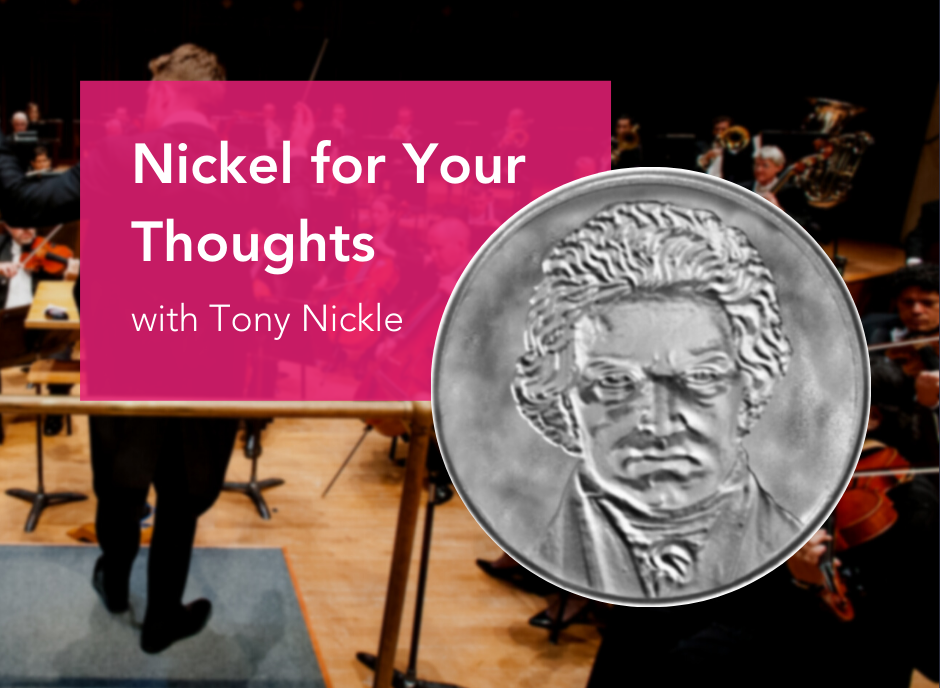In his own words, Artistic Administrator Tony Nickle shares what he believes to be the high points of the program, but with a little edge and humor for good measure.
Happy Ides of March and St. Patty’s, everyone. This week’s program is such a juicy delight, featuring my favorite of all Beethoven symphonies and an organ concerto that shows off everything a modern organ is capable of. Let’s start with Beethoven and save the organ concerto for dessert…
For me, Beethoven’s Seventh Symphony is all about the rhythm. Everyone talks about the rhythmic motive that pervades the Fifth; and rightly so, because it was pioneering to have one idea connect an entire symphony across four movements. But, the Seventh uses rhythm in a way that drives us forward even in ways that the Fifth does not. Beethoven crafts a unique rhythmic quality for each individual movement, and in any other symphony each would likely be considered the strongest piece of the puzzle; as it is we just have four incredible parts, each as astounding as the next. The first movement is all about dotted rhythms, which takes melodic figures and creates asymmetry through alternating elongation and compression. In short that means longer notes followed by quick ones; long – quick – long – quick quick – long, and on and on. That asymmetry keeps us endlessly moving forward like a tireless, skipping five-year-old. And here’s a loosely related sidenote: the first movement begins unlike any symphony that came before. It begins with a slow introduction – big, sturdy, forte block chords with slow, soft melodic interludes. Slow intros preceding the main, fast material in a first movement weren’t revolutionary as Haydn codified the practice many years earlier. But, those slow intros were typically a section unto themselves, with a nice V – I cadence into the first real theme of the symphony. In his Seventh Symphony, Beethoven allows material from the fast, first theme to peek through during the slow intro, giving us a hint of what’s about to come, and then elides into it without a stark division. For audiences who were used to Haydn’s approach (and they were quite cultured and used to custom), this would have been shocking on first listen.
The second movement is, without question, the most famous of the symphony. I know I said that each movement is equally astounding, but the truth of the matter is that this one is the sun among the shining stars. It has a funeral march-like rhythm – long, short short, long – that never relents throughout. It’s profound, soaring, powerful, fatalistic, and vulnerable all at the same time. The third movement makes me think about an unbridled fold dance: bubbly and fun, yet earthy. And the fourth movement, well, it’s almost like a bacchanalian runaway train, but still with a bit of the folksy vibe from the third movement. It’s difficult to think of another symphony that never stops pushing you forward even for a moment.
Following that breathless ride, we’re excited to welcome back the outstanding organist, Greg Zelek. Greg has performed here on the mighty Bryan Concert Organ several times, but this is his first appearance on the Masterworks Series. He’ll be playing Joseph Rheinberger’s Second Organ Concerto, which as a late 19th-century piece does showcase so much of what a modern organ can do, whereas organ music written by Handel and Bach weren’t really written for the same scale. The piece isn’t particularly layered or profound, but it is a delightful cheeseburger. In some ways it is a perfect piece to follow the brilliant and endlessly driving Beethoven. I very much hope you join us this weekend for this joyous pair.
By Tony Nickle, Artistic Administrator


